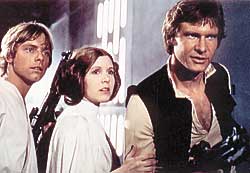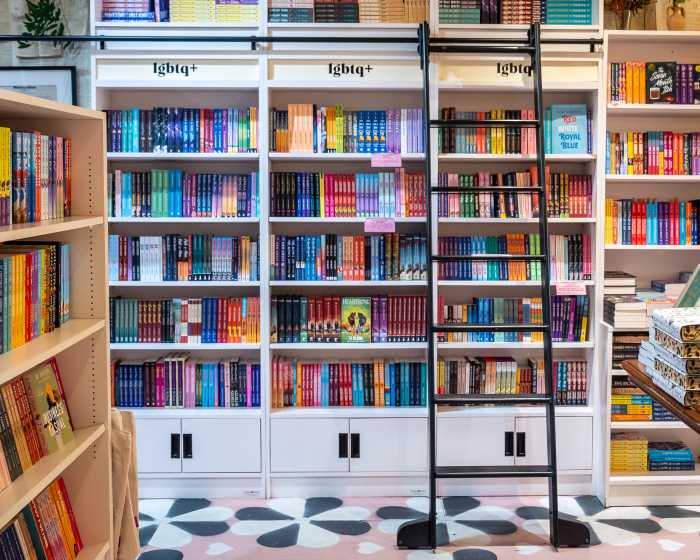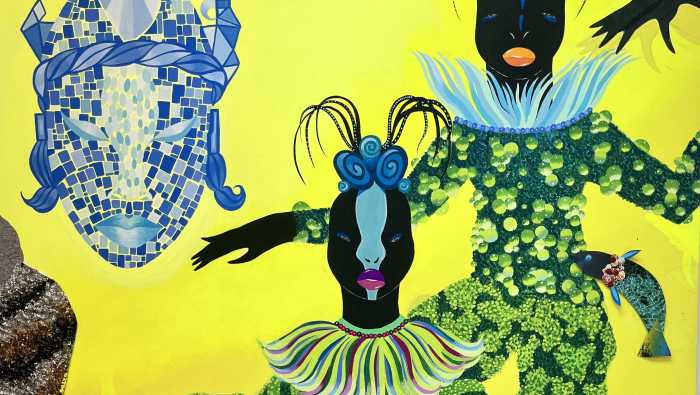Like Luke Skywalker peeling off Darth Vader’s helmet in "Return
of the Jedi," a Brooklyn Museum of Art exhibit this April
will give visitors the opportunity to see the inner workings
of George Lucas’ famed "Star Wars" film series.
Before they were lit, put to music and captured on film, the
components that make up "Star Wars" – the spacecraft
models, the costumes and storyboards – were all sketched and
created by master craftsmen. Those artifacts will be on display
from April 5 through July 7.
And while some herald "Star Wars: The Magic Myth" as
a long overdue tribute to a 20th-century phenomenon that will
bring masses to the Brooklyn Museum, others argue that the exhibit
is just another cog in a Hollywood merchandising machine.
Is there anyone who isn’t familiar with "Star Wars"?
Haven’t we already seen the films, the re-mastered VHS cassettes
and DVDs, the figurines, the "Star Wars" Trivial Pursuits
board game? Each of the 12 "Star Wars" spin-off novels
have been New York Times bestsellers, according to the Lucas
Film Web site.
"It has sort of a bad rep in terms of being an artful film,"
said Matthew Buchholz, manager of the Brooklyn Academy of Music’s
BAMcinematek film series. "It was a model for the blockbuster,
grossing over $100 million in the first weekend. After that,
the blockbuster label dominated Hollywood. People talk about
it as the end of the second golden age of filmmaking.
"But what’s wrong with that approach is ’Star Wars’ is meant
to be grand entertainment, not [French filmmaker Jean Luc] Godard,"
he said. "It’s about creating a mythology for a generation
that didn’t have one."
While the films themselves certainly don’t necessitate close
intellectual analysis, said Buchholz, the "Star Wars"
exhibit is an opportunity to more closely examine the phenomenal,
enduring success of the series.
"Why did it make so much money?" asked Buchholz. "’Titanic’
can be explained. It had Leonardo DiCaprio and it was sold well.
Millions of teenage girls saw it five times. That’s a shallow
thing to say, but there were market forces at work.
"’Star Wars’ had no stars except for Alec Guinness, and
he was not well known to Americans," he said. "Science
fiction films weren’t popular. So one of the questions that is
overlooked is why is ’Star Wars’ so important to our culture,
and why can’t we get away from it? I think that’s something the
museum’s show addresses in dealing with the art of it."
Brooklyn Museum director Arnold Lehman recalls seeing the first
"Star Wars" film in 1977, when he first encountered
the phenomenon.
"We were living in Florida," said Lehman. "I had
both of our kids with us and we stood in line for several hours
to see it. You were just blown away because of the incredible
special effects and the story line." And in February 2000,
when Lehman went to the opening of the "Star Wars"
exhibit at the Minneapolis Institute of Arts, "I went in
costume as Darth Maul [from "Episode I: The Phantom Menace"].
The director of the institute wore a costume and the trustees
did, too. It was a really wonderful moment," he said.
"’Star Wars’ has been a part of our visual history for over
a quarter of a century," said Lehman, 57, "and very
few people are untouched by it."
Buchholz, 25, agreed. "I grew up with these films. But when
I watch the films, I get caught up in the films themselves. One
of the things that interested me about seeing the ’Star Wars’
exhibit at the Barbican Center [in London] is that I noticed
the details – that Han Solo’s costume is derivative of Westerns,
with tight pants, boots and a gun off to the side. The Jedi’s
costumes are very derivative of samurai robes worn in Kurosawa’s
films. [’Star Wars’ artists] are taking elements from a lot of
different sources."
In addition to Han Solo, the exhibition includes more than 30
mannequins with costumes worn by Luke Skywalker, Princess Leia,
Obi-Wan Kenobi and other "Star Wars" characters.
Matthew Yokobosky, a former film and video curator at the Whitney
Museum and exhibition designer for "Star Wars," said
that the appeal of this exhibit’s costumes is akin to the worldwide
obsession with royalty.
"I think it’s fascinating to see clothing worn by an actor,
in person," said Yokobosky. "The Marilyn Monroe dress
in ’Bus Stop’ or Judy Garland’s ruby slippers. People often talk
about how Hollywood is the new royalty. The ’Star Wars’ designs
are really wonderful and innovative and very much contributed
to an evolution in Hollywood."
Art or opportunism
Daily News columnist John Leo, however, believes the exhibition
does not fall under the heading of "art" and further
charges that the installation of this exhibit is financially
motivated.
Leo, under an editorial headlined "This ain’t art"
on May 5, 2001 wrote, "A hugely successful traveling ’Star
Wars’ exhibit points the way toward more and more money-driven
decisions."
Lehman, who is no stranger to controversy having hosted the "Sensation"
exhibit in 1999, which drew charges of commercialism and Catholic-bashing,
said drawing in visitors in order to take their money is not
the goal of the Brooklyn Museum. Its mission, he said, is to
offer art to the masses.
"We felt the merit of this exhibition is that it would be
relevant and resonate with a broader community," Lehman
told The Brooklyn Papers. "That’s very important. That’s
part of our mission, to have a greater engagement with a broader
audience.
"We don’t look at exhibitions in terms of dollar signs,"
said Lehman. "We look at exhibitions in terms of how to
serve the mission of the museum. We plan to the best of our ability
to break even. That’s how we organize ourselves. Sometimes we
break even, sometimes we don’t do as well, but we budget very
carefully. We are hopeful we have a very large audience, but
the finances are complicated. The cost for a show like this is
very large. It’s two full floors with lots of labor."
Lehman said that the components of filmmaking are directly related
to the museum’s mission as well.
"The museum very actively collects design, costumes, photography
and works on paper, all of which relate to what we’ll be showing.
We do collect most of the component parts of what makes any film.
It relates directly to what we do as an institution."
A huge draw
Lehman is in good company in his belief in the artistic merits
of "Star Wars: The Magic of Myth." As he points out,
the exhibition has been on tour for two years at many "fine
arts" institutions in the United States, and it was organized
by "our federal institution," the Smithsonian Institution
Traveling Exhibition Service (SITES).
When "Star Wars" was at the Smithsonian’s National
Air and Space Museum in Washington, DC, it attracted more than
a million visitors and was one of the most visited Smithsonian
exhibitions of all time.
According to Elizabeth Sudheimer, communications manager of the
Toledo Museum of Art in Ohio, the exhibit reeled in 99,323 visitors
from Aug. 5, 2001 through Jan. 5, 2002. She said the museum is
celebrating its centennial year, and "Star Wars" marked
their sixth largest attendance for a show. The museum charged
$7.50-$10 for tickets.
"We are glad we had [’Star Wars’]," said Sudheimer.
"It was definitely a success. In the last three days of
the exhibit, with [an advertising campaign with] a lot of ’Darth
Vader is leaving the building’ kind of stuff, we had over 12,000
people."
Sudheimer said the Toledo Museum did receive criticism when they
announced they were holding the "Star Wars" exhibition.
"Initially we did have an interesting reaction from local
media, but they all changed their mind once they saw the exhibit,"
said Sudheimer. "First of all, moviemaking is an art form,
and there’s a variety of art in the exhibit: models, beautiful
drawings, the costumes."
The exhibit is likely to be well attended at the Brooklyn Museum,
too, because it has the considerable benefit of coinciding with
the marketing extravaganza that will precede the summer release
of the next film in the "Star Wars" series, "Episode
II: Attack of the Clones."
Lehman said the museum would sell tickets to the exhibit, which
would include admission to the rest of the museum, for specific
show times.
"We’ll be prepared to handle large crowds of people and
make the experience as pleasurable and meaningful as we possibly
can," said Lehman.
The Brooklyn Museum’s version of the "Star Wars" exhibit
is one of the most comprehensive to date including the red velvet
Queen Amidala gown, worn by actress Natalie Portman, in the latest
in the series, the prequel to the first three, "Episode
I: The Phantom Menace."
Another way the Brooklyn Museum will distinguish itself is in
its exhibition design. Designer Yokobosky said, unlike other
museums, which displayed the artifacts in a "black-box"
setting, he is creating an "envelope of environment"
around the pieces. The rooms containing artifacts from the desert
scenes "will be painted like a desert with blue sky. The
ice planet Hoth room, from ’Empire Strikes Back’ will have grays
and blues of the mountains to evoke the icy landscape."
Lehman said that another boon to Brooklyn will follow the opening
of "Episode II: Attack of the Clones" this summer –
the museum will receive costumes from that film to display, as
well.
For "Star Wars" junkies who want their fix a bit earlier,
on Feb. 2, the Brooklyn Museum’s next free First Saturday event,
guests can see the models of rebel droids R2-D2 and C-3PO in
the grand lobby.
Place in history
Sudheimer said the "Star Wars" exhibit at the Toledo
Museum had a broad appeal, and people could identify with the
artifacts – even posing for photographs next to characters such
as Darth Vader or Jabba the Hutt. She said several generations
in a family could enjoy the show at the same time.
"’Star Wars’ may be the new hero, but art has always had
heroes," said Sudheimer. "Grandchildren would educate
grandma and grandpa in the ’Star Wars’ show, but the grandparents
picked up our heroic tradition book and taught them."
Like the Toledo Museum, the Brooklyn Museum will introduce visitors
to objects from its own collection. Titled "The Myth of
the Hero and Heroine," a room set up as a preface to the
"Star Wars" show, will include objects such as a marble
head of Queen Cleopatra VII from the first century B.C., a Yoruba
mask used in festivals commemorating the deeds of ancestral warriors,
and a Rembrandt etching of Faust.
There is also a 30-minute introductory film that examines the
impact of "Star Wars" on late-20th century world culture
and an illustrated catalogue, "Star Wars: The Magic of Myth"
(Bantam, 1997, $24.95) by curator Mary Henderson, which identifies
elements of classical mythology in the "Star Wars"
trilogy and examines the influence of Joseph Campbell’s book
"The Hero with a Thousand Faces" (Princeton University
Press, 1976) on filmmaker George Lucas.
"Arnold really wants to do new and exciting projects,"
said Yokobosky. "He wants people to be engaged with the
museum. It’s all coming together with the ’Star Wars’ show
"[Lehman] wants to encourage rethinking how exhibits can
be put together to attract new audiences and engage them,"
he said," and to make them feel like they’re seeing art
anew."

























